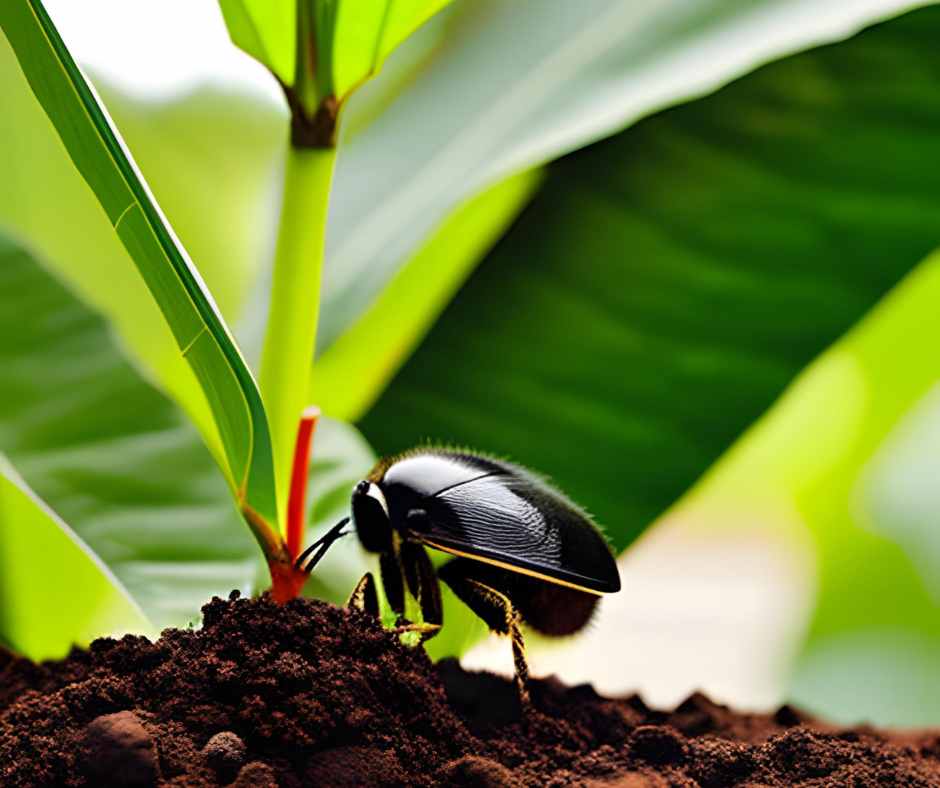Gnats in plants can be a frustrating issue for any plant lover. These small flying insects can quickly multiply and infest your beloved indoor and outdoor plants, causing damage and hindering their growth. In this article, we will explore the world of gnats in plants and how you can effectively deal with them. So, let’s dive in and learn how to overcome gnats in plants coffee grounds struggle.
Gnats are tiny insects that belong to the family of flies. They are commonly found in and around plants, especially in moist environments. The most common gnats that infest plants are fungus gnats and shore flies. These pests can cause various issues and disrupt the health of your plants.
Understanding the life cycle of gnats
Before we delve into the problems caused by gnats and how to control them, it’s important to understand their life cycle. Gnats go through four main stages: eggs, larvae, pupae, and adult gnats. By understanding each stage, we can better comprehend their behavior and implement effective control methods.

How gnats affect plants
Gnats can negatively impact your plants in several ways. Firstly, their larvae feed on the organic matter in the soil, including the roots of plants. This can lead to root damage and weaken the plant’s overall structure. As a result, the plant’s growth may become stunted, and it may struggle to absorb nutrients effectively. Furthermore, gnats can transmit diseases to plants, further compromising their health.
What Smell Do Gnats Hate?
Ah, gnats! Those tiny, bothersome creatures always seem to find their way into our lives, buzzing around and causing a nuisance. If you’ve ever dealt with a gnat infestation, you know how frustrating it can be. But fear not, because there are ways to repel these pesky insects and keep them at bay.
When it comes to gnats, they have a keen sense of smell that helps them locate food sources and potential breeding grounds. If we can find a scent that they despise, we might just be able to discourage them from sticking around. So, what smell do gnats hate? Well, let’s dive into it!
One scent that gnats can’t stand is the aroma of vinegar. Yes, that’s right, good old vinegar! Gnats find the acidic scent of vinegar to be highly repulsive. You can create a simple homemade gnat repellent by mixing equal vinegar and water in a spray bottle. Then, spritz the solution in areas where you’ve seen gnats buzzing, such as near windows, doors, or plants. Not only will this help keep the gnats away, but it’s also a natural and safe option.
Another scent that gnats find unpleasant is the smell of citronella. You’ve probably heard of citronella candles being used to ward off mosquitoes, but it turns out that gnats dislike the smell as well. Citronella has a strong, lemony fragrance that repels these tiny pests. Consider using citronella essential oil in a diffuser or lighting citronella candles in your outdoor spaces to deter gnats from coming too close.
Identifying gnats in plants

To effectively combat gnats, it’s crucial to identify their presence in your plants. Visual signs such as small flying insects around your plants or on the soil surface indicate a gnat infestation. You can also use sticky traps to catch these pests and confirm their presence.
Picture this: you’ve got a beautiful indoor or outdoor garden, and suddenly, you notice these tiny flying insects hovering around your plants. Those little buggers are called gnats and can be quite a nuisance. But what brings them to your plants in the first place?
One of the primary causes of gnats in plants is moisture. You see, these critters love damp environments. When the soil in your potted plants or garden beds becomes overly moist, it creates the perfect breeding ground for gnats. It’s like an all-you-can-eat buffet for them, with the moist soil providing them with an ideal spot to lay their eggs.
Now, you might wonder how that excess moisture enters your plants. There are a few common culprits. Overwatering is a major one. Giving your plants more water than they need can lead to waterlogged soil, creating the moist conditions that gnats find so inviting.
Another source of moisture is decaying organic matter. Dead leaves, fallen flowers, or decomposing plant material can accumulate in your pots or garden soil. As this organic matter breaks down, it releases moisture, which acts as a magnet for gnats. It’s like an all-you-can-eat buffet combined with a cozy little gnat hotel.
But here’s the good news: you don’t have to surrender your plants to these annoying pests.
10 Natural Ways To Eliminate Gnats in Plants Coffee Grounds
Just like annoying little pests that invade your space, gnats can really bother your beloved plants. These tiny insects love to hover around your indoor plants, causing irritation and potentially harming your green friends. But worry not! There are some simple, natural solutions to bid farewell to these pesky gnats and keep your plants thriving.
Let your plants dry out:
Just like vampires, gnats don’t do well in dry environments. Allowing the top layer of soil to dry out between waterings makes your plant less attractive to these unwanted guests. Remember, moderation is key when it comes to watering.
Use sticky traps:
Think of sticky traps as a spider’s web for gnats. These traps have a sticky surface that lures the gnats in, capturing and preventing them from flying around your plants. Place a few traps near your plants, and watch as the gnats get stuck and disappear.
Employ natural predators:
Nature has its way of dealing with pests. Consider introducing natural predators like beneficial nematodes or predatory mites to your plant’s environment. These little heroes feed on gnats’ larvae and eggs, helping control their population naturally.
Create a vinegar trap:
Gnats have a sweet tooth, and vinegar can be their downfall. Fill a small dish with apple cider vinegar and a few drops of dish soap. The sweet scent of the vinegar attracts the gnats, and the soap breaks the surface tension, causing them to drown.
Try neem oil:
Neem oil, derived from the neem tree, has long been used as a natural insecticide. Dilute it with water according to the instructions on the bottle and spray it on the affected plants. Gnats dislike the smell of neem oil and will steer clear, leaving your plants in peace.
Use cinnamon powder:
Who would have thought that this common spice could come to the rescue? Sprinkle cinnamon powder on the soil’s surface will act as a deterrent for gnats. The aroma repels them, making your plants an unattractive hangout spot.
Incorporate sand or diatomaceous earth:
Gnats like moist soil, sand, or diatomaceous earth can help absorb excess moisture. Mix some sand or diatomaceous earth into the top layer of soil, creating an inhospitable environment for gnats to lay their eggs.
Opt for hydrogen peroxide:
A mixture of hydrogen peroxide and water can help kill off gnat larvae. Mix one part hydrogen peroxide with four parts water and water your plants with this solution. It’ll break down into water and oxygen, leaving your plants healthy and free from gnats.
Practice good hygiene:
Just like washing your hands keeps germs at bay, maintaining good plant hygiene can prevent gnat infestations. Remove dead leaves, fallen debris, and overripe fruit from the vicinity of your plants, as these can attract gnats.
Introduce essential oils:
Certain essential oils, such as lavender, peppermint, and eucalyptus, have powerful scents that gnats dislike. Dilute a few drops of essential oil in water and spray it on your plants. Not only will this repel the gnats, but it will also add a pleasant aroma to your indoor garden.
Remember, patience is key when dealing with gnats. Combining these natural methods will help you eliminate the gnats and keep your plants happy and healthy.
Prevention and control methods
Prevention is key when it comes to managing gnats in plants. Here are some effective methods to keep these pests at bay:
- Removing excess moisture: Gnats thrive in damp environments, so it’s essential to ensure proper drainage and avoid overwatering your plants.
- Allowing soil to dry between waterings: Gnats prefer moist soil, so allowing it to dry out slightly between waterings can help discourage their breeding.
- Using coffee grounds as a natural deterrent: Coffee grounds are a natural repellant for gnats. Sprinkling used coffee grounds on the soil surface can help deter these pests.
- Using beneficial nematodes: Beneficial nematodes are microscopic organisms that feed on gnat larvae. They can be applied to the soil to control the gnat population.
- Using insecticidal soap: Insecticidal soap is a safe and effective option for controlling gnats. It can be sprayed directly on plants and soil to eliminate these pests.
Other natural remedies for gnats in plants
Apart from coffee grounds, several other natural remedies can help combat gnats in plants:
- Neem oil: Neem oil is a plant-based insecticide that can be mixed with water and sprayed on plants to eliminate gnats.
- Hydrogen peroxide solution: Diluted hydrogen peroxide can kill gnat larvae in the soil. Apply the solution to the affected areas and let it soak.
- Cinnamon powder: Sprinkling cinnamon powder on the soil can repel gnats due to its strong scent.
- Sand or gravel as a top dressing: Adding a layer of sand or gravel on top of the soil can prevent adult gnats from laying eggs in the moist soil.
Here are some additional tips to help you effectively manage gnats in your plants:
- Ensure proper drainage in your plant containers to prevent excess moisture buildup.
- Regularly clean your plant containers to remove organic matter that may attract gnats.
- Avoid overwatering your plants, as this creates an ideal environment for gnat breeding.
How do coffee grounds attract pests?

Coffee grounds have an interesting effect on pests. Imagine this: sitting down at your favorite coffee shop, sipping on your aromatic cup of joe, and enjoying the cozy ambiance. Suddenly, you notice a little critter scurrying across the table. You can’t help but wonder, do coffee grounds attract bugs?
Well, let’s take a closer look at this question. While coffee grounds do have a strong and enticing aroma, they are not necessarily a beacon for pests. Just like humans, pests have unique preferences and dislikes when it comes to smells and tastes.
You see, pests are more attracted to certain food sources that provide them with the sustenance they need to survive and reproduce. Things like crumbs spilled liquids, and uncovered food are much more enticing to them than coffee grounds. These little creatures are looking for a feast, not a caffeine fix!
Think about it like this: if you were a pest, would you prefer a feast of sugary crumbs or a handful of coffee grounds? I bet you’d go for the crumbs every time! Pests, such as ants or cockroaches, are more likely to be drawn to sugary, greasy, or carbohydrate-rich foods, which are far more appealing to their taste buds (if they had any).
However, it’s important to note that pests are incredibly resourceful creatures. If they are desperate for sustenance and there’s nothing else available, they might give coffee grounds a nibble out of sheer hunger. But rest assured. It’s not their go-to snack of choice.
But remember, while coffee grounds can help in deterring pests, it’s still crucial to maintain good sanitation practices. Keep your kitchen clean, seal food properly, and promptly clean up any spills or crumbs. This way, you’re removing their preferred food sources and making your space less attractive to pests.
So, the next time you enjoy your morning cup of coffee, don’t fret about attracting pests with your grounds.
Conclusion
Dealing with gnats in plants can be frustrating, but with the right knowledge and methods, you can effectively control and eliminate these pests. Remember to identify the signs of gnat infestation, implement preventive measures, and utilize natural remedies such as coffee grounds to keep your plants healthy and thriving.
FAQs:
Q: Are gnats harmful to humans?
A: Gnats are primarily a nuisance to humans and do not pose significant health risks. However, some people may experience allergic reactions to gnat bites.
Q: Can coffee grounds attract other pests?
A: No, coffee grounds act as a deterrent for many pests, including gnats. They are unlikely to attract other pests when used in moderation.
Q: How often should I apply coffee grounds to my plants?
A: Apply coffee grounds to the soil surface once a week or as needed to maintain a strong aroma and deterrence.
Q: Can I reuse coffee grounds for gnat control?
A: Yes, you can reuse coffee grounds for gnat control. After they dry out, you can collect and reuse them multiple times.
Q: Are chemical insecticides safe for gnat control in plants?
A: Chemical insecticides should be used with caution around plants. Opting for natural and organic methods before considering chemical options is advisable.
Tags: coffee Grounds, Gnats in Plants



